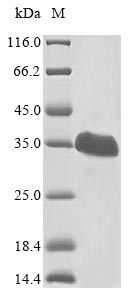The recombinant Human VHL was expressed with the amino acid range of 1-213. This VHL protein is theoretically predicted to have a molecular weight of 28.2 kDa. This protein is generated in a e.coli-based system. The N-terminal 6xHis tag was smoothly integrated into the coding gene of VHL, which enables a simple process of detecting and purifying the VHL recombinant protein in the following steps.
The human Von Hippel-Lindau disease tumor suppressor (VHL) is a critical protein that plays a key role in the regulation of cellular responses to oxygen levels. It functions as a tumor suppressor by targeting specific proteins for degradation, particularly under conditions of normoxia (normal oxygen levels). VHL is best known for its role in the ubiquitin-proteasome pathway, where it serves as the substrate recognition component of an E3 ubiquitin ligase complex. In normoxic conditions, VHL binds to hypoxia-inducible factor (HIF), marking it for ubiquitination and subsequent degradation. HIF is a transcription factor that, under low oxygen levels (hypoxia), would typically induce the expression of genes involved in angiogenesis and glycolysis. Therefore, VHL indirectly regulates the cellular response to hypoxia by preventing the accumulation of HIF. Mutations in the VHL gene are associated with Von Hippel-Lindau disease, a hereditary cancer syndrome characterized by the development of tumors in various organs. Research on VHL often explores its intricate involvement in cellular oxygen sensing, angiogenesis, and tumor suppression.




